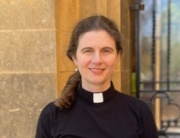A Sermon by The Rev’d Adrian Stephens
“My Soul proclaims the greatness of the Lord: my spirit rejoices in God my saviour, Who has looked with favour on his lowly servant: from this day all generations will call me Blessed.” – The Magnificat
Mary, the Mother of Jesus, has been the cause of some ecumenical challenges over the years. In my mind she is the greatest of the servants of God. It is Mary who gave birth to the Son of God. It is Mary who stood by his side throughout his ministry. It is Mary who knelt at the foot of the cross weeping for her son as he died that gruesome death. Mary is the mother of Jesus and the true example of a servant of God.
Unfortunately, her role is also manipulated in such a way that when we say we prayed the Angelus with Mary, or that we have asked Mary to pray for us, we are risking an attack on our integrity for placing Mary before Jesus. We can be accused of worshiping Mary in the place of God. This is most unfortunate and a terrible misunderstanding of the role and ministry of Mary. It is also a misunderstanding of all the Saints. We often ask the saints to pray for us. In my understanding this is no different than me asking you to pray for me. Alive or departed we are the saints of the Church, and we are called to pray for each other.
While we claim that Anglican theology is focussed on Christ, Bible based, catholic in tradition and explored with reason, we can also make room for the movement and influence of the Holy Spirit. The early Anglican Church recognised Mary as the most important Saint in the church. This is supported by the fact that there are five separate feast days for the recognition of her role in the faith. Today is the day we call “Mary, the Mother of our Lord”. The Roman Church call it “The Assumption of Mary”, while the Orthodox church title it as the “Falling Asleep of Mary”.
The other four in sequence are, the Purification, the Annunciation, the Visitation, and the Conception. No other saint is recorded and recognised with five festival days every year. Mary is indeed the most important saint in our faith.
Unfortunately, we have had need to sidestep such divisive things as the Dogma of the Immaculate Conception introduced by Pope Pius 1X in 1854. There is no biblical evidence to support this feast. Pope Pius X11 introduced the Assumption, the bodily raising of Mary to heaven. This cannot be supported by scripture either. When a previous Archbishop of Canterbury was challenged concerning the Assumption his response was simple. “If Mary is not in heaven, then where is she?” there are other challenges to our acceptance of Mary as being an important saint.
In one of my previous parishes the Angelus was recited after morning and evening prayer on weekdays and after the main Eucharistic service on Sunday. I will not recite it now, but rather than being about Mary, it is in fact a recognition of the incarnation of Jesus. Sadly, someone from time to time would complain about this “Mary stuff” that we included in the faith. That is OK. Our regional bishop knew that the Angelus would be said so he would process out of the church prior to it being said. With the speaker in the porch he could hear it perfectly well from the footpath outside.
At the time of the reformation and during the influence of Cromwell, together with the dissolution of the Monasteries, there was much angst in the community regarding anything to do with Mary, and indeed any monument or statue or an image of any of the saints. These were considered to be objects of idolatry. There are many accounts of the destruction of beautiful religious objects.
Ely Cathedral was used as a stable by Cromwell’s soldiers. They are reputed to have ridden around the cathedral on horseback intentionally chopping heads and hands from all the statues. The Lady Chapel was the worst vandalised. The magnificent and incredibly tall stained glass windows were destroyed because they were classified as heretical. The reality was that the population was primarily illiterate, and the windows depicted biblical scenes that were used as teaching aids. This fundamental meaning eluded these destructive vandals.
There is a little chapel not far from York Minster that has a history which goes way back in time. Unfortunately, I cannot remember the name of this chapel. There are so many people buried under the floor of that little church that the floor rises and falls like small waves on the sea.
In the East window, the window over the altar, there is a medieval image of Mary being crowned as the Queen of Heaven. I am amazed that this image survived the iconoclasts. When many stained glass windows were vandalised and destroyed, this window depicting the crowning of Mary as Queen of heaven, survived.
I find it to be particularly sad that there can be any negative reaction to Mary. Perhaps it is more of a reaction to the Mariology that existed many years ago. Perhaps it is a leftover from a particularly patriarchal society. Perhaps she simply slips from the mind when we think of the structure of our faith and religion. Whatever the reason it seems that there is some resistance to fully acknowledging her importance in our faith and in our lives.
At the Annunciation her response to God was simple. “Behold, I am the handmaid of the Lord: let it be unto me according to your word.” Her example of obedience, and trust, is a very valuable lesson for each one of us. When God is calling, do we respond with that simple and accepting action of Mary, or do we question and try to sidestep that call? It is a real question and will have different answers for each one of us.
One of the more significant actions of Mary, apart from her obedience, trust, pregnancy, birth of Jesus, faithfulness, and loyalty to the call that God the Father requested, is this. She was present at the wedding in Cana of Galilee, and she was influential in directing people to obey her Son. We recall very quickly that it was the occasion when Jesus turned the water into top quality wine. We theologise this in many different ways, and primarily we speak of it representing the coming of Jesus at a particular time in History. In the same way that the steward asked why the best wine was kept until last, the ministry and teaching of Jesus has been kept until now. Yes, we remember the water and wine, but how many of us remember Mary telling the servants to do whatever Jesus tells them to do?
This is a primary teaching of Mary. She directs all of us to listen to Jesus and to do whatever he tells us to do. This is the call on our lives. This is the new message from Mary. In the first instance it is obedience and trust. And now it is a teaching us to listen and to act. Do whatever he tells you to do.
We note in iconography that when Mary and child are written together, Mary is generally depicted as presenting her child to us. She is almost always written in such a way that she is holding Jesus forward for us to recognise and to accept.
In this way Mary is pointing us to Jesus. This is her lesson, and it is for us to imitate her teaching. It is for us to lead people and to encourage them to listen for the teaching of Jesus and to do as he says. I do not mean this to be some esoteric super spiritual exercise in listening for voices. I mean it as the result of our prayer and meditation on the word of God. It is a response to our discernment of God’s call on our lives.
Our prayer is indeed a two way thing. We speak to God, and we listen for God. We encourage others to listen for God and in their turn to look to our Lord in faith and hope.
Today we give thanks for the faithfulness of Mary, blessed Virgin and Mother of our Lord Jesus.





